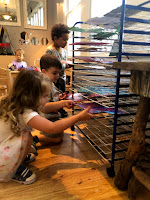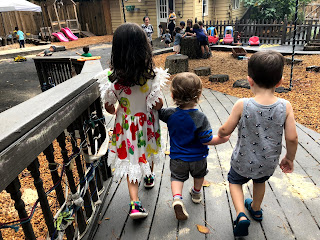Kitah Alef Morahs took this as a learning moment, and realized this is just the kind of beginning stage the Emergent Curriculum model uses- follow the interests of the child. It is admittedly something we've been wondering in the younger classes... how to let a curriculum emerge from students who are either pre or early verbal. We learned about following the gaze of the child as a way to perceive interests, but here, on this walk the answer was delivered to us so clearly. Pay attention to their words! Their words tell us plenty.
While visiting the 100 Languages of the Child exhibit, a remarkable summary of the Reggio Emilia philosophy, we saw one exhibit about writing that stood out to us teachers. It was documentation of "writing" from children of all ages (very young toddlers to six year olds), with text that spoke about how before written language is the vehicle of knowledge, it itself is knowledge. Meaning that just the act of mark-making, attempting lines and letters, also contains ideas.
In the classroom we put out paper and marker on our class easel. We wondered how this would pan out. We saw focus, wonder, and legitimate interests playing out in front of us.



Eventually, all of the friends were gathered around, wanting to join in, so we moved to the tables. Seated, each student got a crayola marker and a piece of paper. We saw the most elegant line drawings; a far cry from the expected scribbles (also valuable) and blue tongues. Seeing this, I remembered one of the most important tenants of Reggio Emilia: a view of the child as capable. One of the Morahs remarked how much their lines resembled writing, and an idea sprang up.
Over the next few months, we'll be following this idea as far as it goes. We've printed off words we've documented the students saying, images of those words "moon" and a picture of the moon, and will be using them as provocations during art time in our classroom. We also hope that we can make our own images of the words for instance, "shovel" has been a popular word in our class recently, so an image of a friend holding a shovel, rather than a stock image of a shovel. During the time that students are exposed to these texts and images, we'll watch carefully, document, and see what emerges. And of course, we will gladly keep you updated of our discoveries!

































